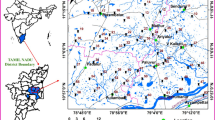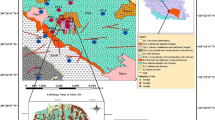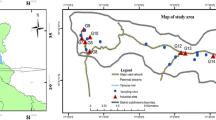Abstract
The aims of this study are to investigate the potential origin of selected heavy metal(loid)s in the Shabestar plain, NW Iran, by means of multivariate statistical techniques (cluster analysis and factor analysis), as well as to determine the dominant factors that affect groundwater quality and to assess the health risk induced by metal(loid)s using the hazard quotients (HQ). Totally, 29 groundwater samples were collected from wells in August 2016, and the values of 23 parameters, namely pH, electrical conductivity, concentration of major elements (Ca2+, Mg2+, Na+, K+, HCO3−, SO42−, Cl−), minor elements (NO3−, F−, B, and Br−) and heavy metal(loid)s (Fe, Al, Cr, Mn, As, Zn, Pb, Cu, and Ni) were measured. The results indicate that some samples were found with As, Pb, and Zn concentrations exceeding WHO standards for drinking water. Results of correlation coefficients between the measured variables reflect the occurrence of weathering and dissolution of rocks, especially silicates and evaporites, with ion exchange and geochemical characteristics similar to the release of some heavy metal(loid)s. According to hierarchical cluster analysis, samples of cluster 1 are affected by alkalinity and accompanied by elements compatible with alkaline ambience (CO32− and Ni). Samples of subcluster 2-1 demonstrate the effect of salinity, attributed to evaporates, irrigation return flow, and influx of Urmia Lake’s brine, while, samples of sub-cluster 2-2 are influenced by agricultural activities. Factor analysis results illustrate the effects of five factors on the quality of groundwater. The factor analysis accounts for the 71.9% of total variance of groundwater quality for geogenic impacts, while 10% of the groundwater quality variance is controlled by agricultural activities which produce excessive amounts of NO3− along with Zn which is contained in fertilizers and agrochemicals. The results of the human health risk assessment show that As is the most dominant metalloid in inducing maximum noncarcinogenic risk among all the heavy metal(loid)s. Based on HI, 45 and 14% of the samples for children and adults, respectively, are found to be in high risk category.








Similar content being viewed by others
References
Adriano DC (2001) Trace elements in terrestrial environments: biogeochemistry, bioavailability, and risks of metals, 2nd edn. Springer, New York
Asadian O, Mirzaee AR, Mohajjel M, Hadjialilu B, Eftekhar Nezhad J (2007) Geological quadrangle map of Marand in Iran. Geological Survey of Iran, Tehran
Asghari Moghaddam A, Mohammadi A (2003) Sources of salinity in groundwater of Shabestar plain aquifers. J Agric Sci (University of Tabriz) 13(3):69–78
Asghri Moghaddam A (1991) The hydrogeology of the Tabriz area, Iran. Ph.D. Dissertation, Department of Geological Sciences, University College London
Balkhair KS, Ashraf MA (2016) Field accumulation risks of heavy metals in soil and vegetable crop irrigated with sewage water in western region of Saudi Arabia. Saudi J Biol Sci 23(1):32–44
Barzegar R, Asghari Moghaddam A, Kazemian N (2015) Assessment of heavy metals concentrations with emphasis on arsenic in the Tabriz plain aquifers, Iran. Environ Earth Sci 74(1):297–313
Barzegar R, Asghari Moghaddam A, Baghban H (2016a) A supervised committee machine artificial intelligent for improving DRASTIC method to assess groundwater contamination risk: a case study from Tabriz plain aquifer, Iran. Stoch Env Res Risk Assess 30(3):883–899
Barzegar R, Asghari Moghaddam A, Najib M, Kazemian N, Adamowski J (2016b) Characterization of hydrogeologic properties of the Tabriz plain multi-layer aquifer system, NW Iran. Arab J Geosci 9(2):1–17
Barzegar R, Asghari Moghaddam A, Tziritis E (2016c) Assessing the hydrogeochemistry and water quality of the Aji-Chay River, northwest of Iran. Environ Earth Sci 75(23):1486
Barzegar R, Asghari Moghaddam A, Tziritis E (2017a) Hydrogeochemical features of groundwater resources in Tabriz plain, northwest of Iran. Appl Water Sci 7(7):3997–4011
Barzegar R, Asghari Moghaddam A, Tziritis E, Fakhri MS, Soltani S (2017b) Identification of hydrogeochemical processes and pollution sources of groundwater resources in the Marand plain, northwest of Iran. Environ Earth Sci 76:297
Belzile N, Chen Y, Gunn J, Dixit S (2004) Sediment trace metal profiles in lakes of Killarney Park, Canada: from regional to continental influence. Environ Pollut 130:239–248
Bhuiyan M, Rakib MA, Dampare SB, Ganyaglo S, Suzuki S (2011) Surface water quality assessment in the central part of Bangladesh using multivariate analysis. KSCE J Civil Eng 15(6):995–1003
Bortey-Sam N, Nakayama SM, Ikenaka Y, Akoto O, Baidoo E, Mizukawa H, Ishizuka M (2015) Health risk assessment of heavy metals and metalloid in drinking water from communities near gold mines in Tarkwa, Ghana. Environ Monit Assess 187(7):397
Chanpiwat P, Lee B, Kim K, Sthiannopkao S (2014) Human health risk assessment for ingestion exposure to groundwater contaminated by naturally occurring mixtures of toxic heavy metals in the Lao PDR. Environ Monit Assess 186:4905–4923
Chen J, Wu H, Qian H, Gao Y (2017) Assessing nitrate and fluoride contaminants in drinking water and their health risk of rural residents living in a semiarid region of northwest China. Expo Health 9:183–195
Domenico PA, Schwartz FW (1998) Physical and chemical hydrologeology, 2nd edn. John Wiley and Sons Inc, New York, p 506
Duggal V, Rani A, Mehra R, Balaram V (2017) Risk assessment of metals from groundwater in northeast Rajasthan. J Geol Soc India 90(1):77–84
Emberger L (1930) Sur une formule applicable en g’eographie botanique. Cah Herb Seanc Acad Sci 191:389–390
Hardle W, Simar L (2007) Applied multivariate statistical analysis, 2nd edn. Springer, Berlin
Hassen I, Hamzaoui-Azaza F, Bouhlila R (2016) Application of multivariate statistical analysis and hydrochemical and isotopic investigations for evaluation of groundwater quality and its suitability for drinking and agriculture purposes: case of Oum Ali-Thelepte aquifer, central Tunisia. Environ Monit Assess 188:135
Jalali M (2010) Groundwater geochemistry in the Alisadr, Hamadan, western Iran. Environ Monit Assess 166(1–4):359–369
Järup L (2003) Hazards of heavy metal contamination. Br Med Bull 68:167–182
Kaiser HF (1960) The application of electronic computers to factor analysis. Educ Psychol Measur 20:141–151
Kumar M, Ramanathan AL, Tripathi R, Farswan S, Kumar D, Bhattacharya P (2017) A study of trace element contamination using multivariate statistical techniques and health risk assessment in groundwater of Chhaprola Industrial Area, Gautam Buddha Nagar, Uttar Pradesh, India. Chemosphere 166:135–145
Navratil T, Shanley JB, Skřivan P, Krám P, Mihaljevič M, Drahota P (2007) Manganese biogeochemistry in a central Czech Republic catchment. Water Air Soil Pollut 186(1–4):149–165
Otto M (1998) Multivariate methods. In: Kellner R, Mermet JM, Otto M, Widmer HM (eds) Analytical chemistry. Wiley-VCH, Weinheim
Panda UC, Sundaray SK, Rath P, Nayak BB, Bhatta D (2006) Application of factor and cluster analysis for characterization of river and estuarine water systems—a case study: Mahanadi river (India). J Hydrol 331:434–445
Piper AM (1944) A graphic procedure in the geochemical interpretation of water analyses. Eos Trans Amer Geophys Union 25(6):914–928
Prüss-Ustün A, Vickers C, Haefliger P, Bertollini R (2011) Knowns and unknowns on burden of disease due to chemicals: a systematic review. Environ Health 10:9
Reimann C, Filzmoser P, Garrett R, Dutter R (2008) Statistical data analysis explained: applied environmental statistics with. R. Wiley-Blackwell, Chichester
Rezaei A, Hassani H, Hayati M, Jabbari N, Barzegar R (2017) Risk assessment and ranking of heavy metals concentration in Iran’s Rayen groundwater basin using linear assignment method. Stoch Env Res Risk Assess. https://doi.org/10.1007/s00477-017-1477-x
Rice E, Baird R, Eaton A, Clesceri L (eds) (2005) Standard methods for the examination of water and wastewater. American Public Health Association, AWWA (American Water Works Association). Water Environment Federation, USA, 21st edn
Salminen R, Batista MJ, Bidovec M, Demetriades A, De Vivo B, De Vos W, Heitzmann P (2005) Geochemical atlas of Europe, part 1, background information, methodology and maps. Geological survey of Finland
Schrijver K (1995) The role of sandstone porosity and permeability in lead source studies, Appalachian thrust belt, Quebec. Econ Geol 90(8):2326–2328
Soltani S, Asghari Moghaddam A, Barzegar R, Kazemian N, Tziritis E (2017) Hydrogeochemistry and water quality of the Kordkandi-Duzduzan plain, NW Iran: application of multivariate statistical analysis and PoS index. Environ Monit Assess 189:455
Srivastava SK, Ramanathan AL (2008) Geochemical assessment of groundwater quality in vicinity of Bhalswa landfill, Delhi, India, using graphical and multivariate statistical methods. Environ Geol 53(7):1509–1528
Stocklin J (1971) Stratigraphic lexicon of Iran. Geological Survey of Iran
Su H, Kang W, Xu Y, Wang J (2017) Assessing groundwater quality and health risks of nitrogen pollution in the shenfu mining area of Shaanxi Province, Northwest China. Expo Health. https://doi.org/10.1007/s12403-017-0247-9
Tziritis E, Skordas K, Kelepertzis A (2016) The use of hydrogeochemical analyses and multivariate statistics for the characterization of groundwater resources in complex aquifer system. A case study in Amyros River basin, Thessaly, central Greece. Environ Earth Sci 75:339
Tziritis E, Datta PS, Barzegar R (2017) Characterization and assessment of groundwater resources in a complex hydrological basin of central Greece (Kopaida basin) with the joint use of hydrogeochemical analysis, multivariate statistics and stable isotopes. Aquat Geochem 23(4):271–298
USEPA (US Environmental Protection Agency) (1989) Risk assessment guidance for superfund, vol I., Human health evaluation manual (Part A) Office of Emergency and Remedial Response, Washington, DC
USEPA (US Environmental Protection Agency) (1999) A risk assessment-multiway exposure spreadsheet calculation tool. United States Environmental Protection Agency. Washington, DC
Ward JH (1963) Hierarchical grouping to optimize an objective function. J Am Stat Assoc 301:236–244
WHO (2011) Guidance for immunotoxicity risk assessment for chemicals. (IPCS harmonization project document; no. 10), Geneva
Yeomans K, Golder P (1982) The Guttman-Kaiser criterion as a predictor of the number of common factors. J R Stat Soc Series D (The Statistician) 31(3):221–229
Yidana SM, Ophori D, Banoeng-Yakubo B (2008) Groundwater quality evaluation for productive uses—the Afram Plains area, Ghana. J Irrig Drain Eng 134(2):222–227
Acknowledgement
The study has been financially supported by the East Azarbaijan Province Water and Wastewater Company. The authors gratefully acknowledge the useful comments and helpful information from the editors and the anonymous reviewers.
Author information
Authors and Affiliations
Corresponding author
Rights and permissions
About this article
Cite this article
Barzegar, R., Asghari Moghaddam, A., Soltani, S. et al. Heavy Metal(loid)s in the Groundwater of Shabestar Area (NW Iran): Source Identification and Health Risk Assessment. Expo Health 11, 251–265 (2019). https://doi.org/10.1007/s12403-017-0267-5
Received:
Revised:
Accepted:
Published:
Issue Date:
DOI: https://doi.org/10.1007/s12403-017-0267-5




